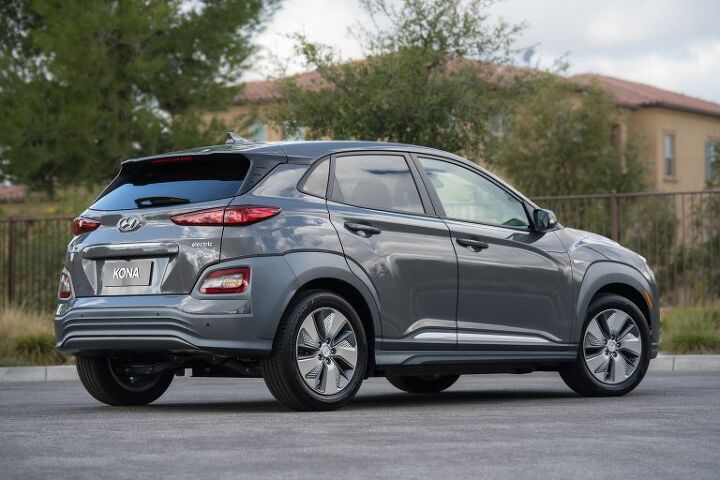2019 Hyundai Kona Electric: Possibly 250 Miles of Range in a Real Crossover That Actually Exists

Last month, Tesla CEO Elon Musk said we’ll learn more about the company’s future Model Y electric crossover — its production date and build location — probably in another six months. Money might start flowing to that project late this year.
Well, by the fourth quarter of this year, electric Hyundai Kona crossovers will actually be arriving in California driveways, followed soon after by Northeastern states and other U.S. locales with zero emission vehicle mandates. This vehicle exists, in the flesh, right now. As the first mainstream crossover EV to land on our shores, the gas-free Kona’s estimated range tops that of the Chevrolet Bolt and (still unproduced) base model Tesla Model 3.
If you can see beyond the Jason Voorhees face, a bland yet revolutionary vehicle awaits.
The Kona Electric made its debut Wednesday at the New York International Auto Show, revealing its mainly featureless, perforated grille in public for the first time. The model is good for 250 miles of driving between charges, Hyundai claims.
If confirmed by the EPA, this range puts it 12 miles beyond the Bolt and 30 miles past the range of the stripper Model 3.
Hyundai’s subcompact crossover achieves this through a large, 64 kWh battery and a single electric motor powering the front wheels. Output stands at 201 horsepower and 291 lb-ft of torque — more than enough power to shave some rubber from the model’s low-drag tires at stoplights (assuming Hyundai allows it to). This tops the grunt of both the base 2.0-liter and uplevel 1.6-liter turbo model.
With its charging port located in the nose and only a small opening in the model’s chin for airflow (aero-improving side curtains appear as inlets on either side), the Kona EV’s light sources appear even smaller than on the gas-powered version. It’s a jarring sight some might require getting used to. The rest of the vehicle is pure Kona, as the EV variant retains the stock model’s gray plastic cladding poured over the wheel arches.
Standard content includes Apple CarPlay and Android Auto connectivity, and buyers can opt for a larger, 8-inch touchscreen (up 1 inch from stock). Available driver aids run the gamut of what you’ve come to expect, and yes, automatic emergency braking with pedestrian detection comes on all models.
The vehicle’s underbody battery pack means cargo space remains the same as in its dino juice-slurping counterparts. Hyundai claims a charging time of 9 hours, 35 minutes at a conventional Level 2 charger, or 54 minutes at a DC fast-charging station (for a zero to 80 percent top-up). Once charged up and underway, drivers can choose from range-saving “normal” and “eco” modes, or hit the “sport” button to open the electron floodgates.
Hyundai will reveal pricing closer to the model’s launch, but expect it to be competitive. Even though the Kona EV is currently the sole occupant of the non-premium EV utility segment, rivals wait in the wings — including Tesla. Well, eventually.
[Images: Hyundai]

More by Steph Willems
Latest Car Reviews
Read moreLatest Product Reviews
Read moreRecent Comments
- SPPPP Vibrant color 9 times out of 10 for me. There may be a few shapes that look just right in metallic gray, for example. There are a few nices ones out there. And I like VW "White Silver". But I'd usually prefer a deep red or a vibrant metallic green. Or a bright blue.
- 28-Cars-Later Say it ain't so, so reboot #6* isn't going to change anything?[list=1][*]V4-6-8 and High "Tech" 4100.[/*][*]Front wheel drive sooooo modern.[/*][*]NOrthSTARt.[/*][*]Catera wooooo.[/*][*]ATS all the things.[/*][*]We're *are* your daddy's Tesla. [/*][/list=1]
- MaintenanceCosts Can I have the hybrid powertrains and packaging of the RAV4 Hybrid or Prime with the interior materials, design, and build quality of the Mazda?
- ToolGuy I have 2 podcasts to listen to before commenting, stop rushing my homework.
- ToolGuy Please allow me to listen to the podcast before commenting. (This is the way my mind works, please forgive me.)




































Comments
Join the conversation
All this talk about electrics, and how nice and warm and fuzzy they make everyone feel. But no one talks much about the down side. At around 80k to 100k the battery pack is shot costing the consumer $10,000 or more to replace( the leaf is cheapest at over $6000 installed)Factor in energy cost at around 17 cents per KWH which in electric car( electric cars need 30kwh to go 100miles) is about $10-11 to drive 200 miles, and you see that the true cost and downside of these things are.
Nice looking car from the front and the flanks... Rear looks like a helicopter dropped it 5 stories high on some other vehicle.